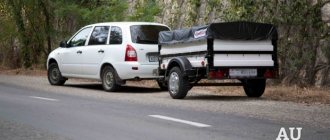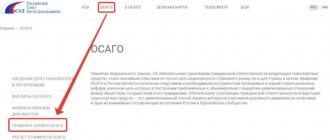What does total mean after an accident?
In the most general and simple case, total loss of a car after an accident occurs when the vehicle is destroyed structurally:
- it was torn apart
- it burned down
- “wrapped” around a pole or tree,
- turned over onto the roof and tumbled until it was completely destroyed.
In this case, everyone understands that it will not be possible to restore the vehicle and its technical characteristics. There is only one way out - scrap metal.
But in some cases, even minor damage at first glance can lead to total liability under compulsory motor liability insurance, for example, if the car’s roof was damaged or the airbags fired.
But there is also an “economic total”!
This concept in most cases appears in insurance cases under compulsory motor liability insurance, since such an event occurs more often than constructive loss of a car.
The very concept of “economic” is a colloquial term intended to immediately draw the attention of the car owner to what is being discussed. And we are talking about the costs of restoring the vehicle. Thus, economic total loss is simply a procedure for calculating payment when it becomes unprofitable for the insurer to restore the car.
When determining whether a car “died” after an accident or not, the expert first approximately, when inspecting the vehicle, and then during the examination, decides whether it is economically feasible or inappropriate to repair and restore this car. If it is not practical to repair it, then they say that the car is a complete loss.
For the purposes of compulsory motor liability insurance, total loss refers to cases where repair of a damaged vehicle is impossible or the cost of repair is equal to or greater than the value of the car at the date of the accident.
Total loss of the car under compulsory motor liability insurance
Methods for recognizing the death of a car are regulated using the Unified Methodology approved by the Bank of the Russian Federation. A conclusion about the loss of a vehicle can be issued by an expert technician who assesses the amount of damage to property and signs the expert report. He works in the interests of the insurance company, so his conclusions may not entirely correspond to reality.
If the owner does not agree with the decision to completely destroy his car, then he has the right:
- provide evidence to the court about the real possibility of restoring the car;
- conduct an independent expert assessment, and, if the experts’ conclusions do not coincide, demand compensation for the difference in assessments through the court;
- in the event of a complete loss of the car, demand an accurate market valuation of the remaining usable spare parts;
- Having an agreement with OSAGO in hand, it is better to renounce the property rights to your car in favor of the insurer.
Complete technical loss of a car occurs if its repair without taking into account wear and tear is more expensive than or equal to its market price at the time of the emergency. The market value of a new car is easy to determine - receipts and contracts will serve as evidence. The cost of repairing an old vehicle will probably exceed its market price at the time of the accident, and suitable spare parts, taking into account their wear and tear, do not have a high value at all. The interests of the insurer in this option lie in significantly understating the market price of the car.
Refund procedure. What to do and what will happen next?
The procedure for applying for insurance compensation under MTPL remains the same.
- You submit an application to the insurance company for insurance compensation or direct compensation for losses (depending on the specific situation) with a full set of necessary documents.
- The insurer is obliged to inspect your car within 5 working days. Since we are talking about whether it is a total car or not, such a vehicle most likely cannot participate in road traffic, and therefore the insurer is obliged to inspect the car at its location, that is, somewhere near your house, in garage or parking lot. There is no obligation to transport the car to the insurer on a tow truck. Even if the insurer says that it will compensate for the costs, I would not do this, since the insurance company will simply deduct the costs of the tow truck from the amount of the payment (after all, the law actually allows them to underpay 10% of the damage).
- In general, within 20 calendar days, the insurer is obliged to organize restorative repairs of your car (issue you a referral for repairs, according to which the car will be repaired) or pay insurance compensation. If it is a total loss, then no repairs can be made and payment is made only in cash.
- Within the same period of 20 days, the insurance company is obliged to report a refusal if it makes such a decision. In this case, the refusal must be motivated.
As you can see, everything here is very simple and standard!
Does the insurance company take the car with total insurance under compulsory motor liability insurance?
If the car is completely destroyed, the owner has the right to decide how to dispose of the usable (surviving) remains. The details can be transferred to the insurance company for sale or kept for yourself.
Article on the topic: Compulsory motor liability insurance at IC Sogaz, how to insure a car online and what is needed for this
If the valid balances are transferred to the insurer, the driver receives the full insurance payment. If the motorist keeps the parts, their cost will be deducted from the compensation amount. In both cases, the insurer will take into account the percentage of depreciation specified in the MTPL agreement.
Insurance companies often cooperate with companies that sell damaged cars. Then the insurance company can offer the policyholder another option - to help sell the usable balances through its partners, and transfer the money to the client. In this case, these funds will be deducted from the compensation amount.
If the driver chooses the option of assistance in implementation, then it is recommended to study the reputation of the partner office. Sometimes insurance companies work with dubious companies that underestimate the cost of sales. If the driver leaves the usable remains for himself, then he can dispose of them at his own discretion - sell them himself or try to repair the car.
How to calculate how much I will be paid?
We have already found out that in case of total compulsory motor liability insurance a payment is due, because this is directly stated in paragraph 16.1 of Article 12 of the Law on Compulsory Motor Liability Insurance. But how much will this payment be?
How much will I receive?
For all cases, we can immediately say with confidence that they will pay no more than the insured amount for compulsory motor liability insurance, which is established by paragraph b of Article 7 of the Law on Compulsory Motor Liability Insurance, that is, no more than 400,000 rubles. This amount cannot be increased, even if the damaged car was much more expensive.
Please note that we are talking specifically about compensation under OSAGO. The missing amount can still be recovered from the person at fault for the accident. More on this below.
How is the cost of a car calculated?
If the car was badly damaged, then it is possible that there were victims in the accident, and therefore you can wait a very long time for documents from the traffic police or the court. Accordingly, the price of cars may either increase or fall during this time.
However, the cost of the car is still calculated on the date of the accident. Even if it was a year ago or two.
This price is determined by the cost of analogue cars, which are taken from information and reference materials. If there are no such materials, then the expert has the right to independently calculate the cost of the analogue using the methods usually used for this type of examination. In practice, in most cases, experts make calculations based on data from sites selling used cars such as avito.ru, auto.ru, etc.
Payment calculation
In cases where the insurer has determined that the insured event is total, the payment is calculated in accordance with clause 18 of Art. 12 of the Law on Compulsory Motor Liability Insurance, namely the difference between the cost of the car at the time of the accident and the cost of the usable remains.
Let's give an example! At the date of the traffic accident, the victim’s car was 2 years old, and its market value was 1,500,000 rubles.
The victim was forced to sue the insurer due to the refusal of compensation. As a result of winning the court, the payment was made, but it was delayed due to litigation for 1 year. And the same three-year-old car costs on average 1,200,000 rubles.
As a result of the accident, the cost of all usable remains was calculated for a total of 600,000 rubles.
In this case, the victim receives... No, not 900,000 rubles, as many thought - 400 thousand.
The calculation here is simple:
- the market value of the car for calculating the total under compulsory motor liability insurance is taken as of the date of the accident - this is 1.5 million rubles,
- then we subtract the valid balances in the amount of 600 thousand and get 900 thousand payable,
- but the maximum insured amount of compensation cannot exceed 400,000 rubles, and therefore the victim receives exactly this limit.
Osago: perhaps total, how is it determined?
If the insurer takes into account the degree of wear and tear when calculating payments, then by the end of the contract the amount of payments is significantly reduced. Policies that do not take this indicator into account are much more expensive.
- The cost of undamaged car parts.
AttentionIf the damage is not very large and you are not the culprit of the accident, then perhaps the payment from the culprit of the accident will be enough to cover the damage. While the insurance company may not pay CASCO insurance.
- Carrying out repair work before the occurrence of an insured event.
As stated above, the owner can dispose of older vehicles at his own discretion, for example, sell or buy a similar car, and make a donor out of a damaged vehicle, especially if you have space to store a second car. By the way, we buy “bitishes”, if you are interested, here is the contact form. And the payment itself under compulsory motor liability insurance in case of complete loss of the vehicle is calculated as the difference between the market value of the vehicle at the time of the accident and the age of the vehicle.
When it is beneficial for the insurer to recognize the constructive loss of a car under compulsory motor liability insurance. Everything is simple here, and the game with calculations is based on the statement that the younger the car, the higher the value of its usable remains. Therefore, in most cases, insurance companies are happy to recognize the car as total in order to pay less, because they pay according to the formula (the market is good).
In order to avoid total 63. The amount of insurance payment in the event of damage to the property of the victim is determined: (clause
"a" in ed. Decree of the Government of the Russian Federation dated February 29, 2008 N 131) Paragraph one of subparagraph “b” of paragraph 63 by decision of the Supreme Court of the Russian Federation dated July 24, 2007 N GKPI07-658 was declared invalid in the part that excludes the amount of loss of marketable value from the insurance payment in the event of damage to the victim’s property.
If there is a difference with the insurance company's assessment, you can also file a lawsuit.
- With compulsory motor liability insurance, it is often more profitable to abandon the car and receive the full amount of insurance without various deductions.
- “Clause 5.5 of the Regulations on the Unified Calculation Methodology:
- Sgo = C * KZ * KV * KOP * ∑ i = 1 NC i 100
- Where:
- C - the cost of the vehicle in an undamaged state at the time of determining the value of the usable remains;
- KZ is a coefficient that takes into account the costs of defect detection, disassembly, storage, and sale;
- CV is a coefficient that takes into account the service life of the vehicle at the time of damage and the demand for its undamaged parts;
- KOP - coefficient that takes into account the volume (degree) of mechanical damage to the vehicle;
- Сi — percentage ratio (weight) of the cost of undamaged elements to the cost of the vehicle, %;
- n is the number of undamaged elements (units, units).”
In many cases, acknowledging the total loss of the car is not beneficial for the policyholder. If this is the case, take all legal measures to prove otherwise.
One of the insured events provided for by compulsory and voluntary types of insurance is the destruction of a vehicle. Payments under CASCO in case of total loss of the car are addressed to the policyholder, and under OSAGO - to the injured party. Recognition of the total is in most cases beneficial for insurers, as it allows them to reduce the amount of insurance compensation.
How can you defend your rights and achieve the maximum possible payment? Dear readers! Our articles talk about typical ways to resolve legal issues, but each case is unique. If you want to find out how to solve your particular problem, please contact the online consultant form on the left or call (ext. 101).
In addition, it is important to consider the costs of dismantling, eliminating minor defects, storing and selling parts.
Is it possible to recover the missing amount of payment from the culprit?
The good news from the example above is that you can recover the rest of the amount of 500 thousand directly from the tortfeasor - the culprit of the accident.
The calculation of the payment was given above solely for the purposes of compulsory motor liability insurance, but as we know, the difference can be recovered from the at-fault driver if the payment under compulsory motor liability insurance does not cover the damage in full.
And here we have bad news for you. In this case, a new methodology of the Ministry of Justice is used to determine this damage. It describes the new rules for conducting forensic automotive technical examinations, which experts must follow in 2021.
According to this methodology, if the cost of restoration repairs plus the cost of loss of marketable value (LCV) is greater than or equal to the market value of the car before damage, then the damage is considered equal to this market value.
As you can see, there are contradictions. For the purposes of compulsory motor liability insurance, the value of the usable remains is deducted from the cost of the vehicle, and in cases of recovery of the difference from the culprit or damage (when the culprit did not have a compulsory motor liability insurance policy), the market value of the car is reimbursed.
But, fortunately or not, our courts smooth out this contradiction with their decisions and do not compensate the market value of the car in full if there are usable remains. They are motivated, in particular, by the fact that the owner of the damaged car will receive unjust enrichment. Judicial practice in such cases is, as a rule, unambiguous - here is one of such decisions, and here is another.
However, we cannot exclude the possibility that the court may decide to recover the full cost of the vehicle from the tortfeasor, but with the transfer of the usable remainder to the person responsible for the accident. And let him try to implement them. Such judicial practice also exists in 2021.
When there is a constructive loss (total) of a car
A complete loss of a vehicle (total) is recognized if the damage to the vehicle is more than 65%. In such a situation, it will not be profitable to restore it - it would be more advisable to send it for recycling or disassemble it for spare parts. Insurance companies may slightly reduce or increase this figure - it all depends on the internal rules of the insurer.
An assessment of vehicle damage after an accident is carried out by an expert, either independent or organized by an insurance company. It determines the size and severity of the damage, as well as the value of the usable remains of the car. Based on the examination, a decision is made whether to recognize the transport as completely destroyed or not. In the first case, the victim will receive monetary compensation, in the second, the car will be sent for repairs.
Will the car be taken?
Insurance under compulsory motor liability insurance differs from voluntary insurance under CASCO, including in that, if the car is recognized as total, no one will take away what is left of it.
But there are also disadvantages to this, because the victim receives less money, since the cost of the usable remains is deducted. And you stay with them and think for yourself how and to whom you will sell them!
What are usable leftovers?
If the car was damaged very badly, but not completely destroyed, then serviceable parts, components and assemblies remain in it, which have some value and can be used in the future, provided that they can be dismantled.
In order for components, components or assemblies to be classified as usable residues, the following conditions must be met:
- under total compulsory motor liability insurance, they should not have damage that violates their integrity,
- must be in marketable condition and in working condition;
- they should not have any holes, cutouts or other structural violations, including for attaching any non-standard equipment;
- the parts must not have been previously repaired.
What if I don't need leftovers?
There are situations when a car that is relatively intact is recognized as total, but due to its low market value and expensive original parts, it is considered completely lost for calculating damage. This often happens with old cars, for which the prices for spare parts and parts according to a single calculation method are expensive.
In this case, of course, it makes sense to repair the car and continue to use it further.
But if the car is structurally damaged or very seriously damaged, then it’s more expensive to deal with the remains. But, unfortunately, you will most likely have to deal with these balances, since the law does not provide for the transfer of usable balances to the insurer under compulsory motor liability insurance.
Thus, the victim is not given the right to choose - to keep intact parts and spare parts for himself and receive a smaller payment, or to give them to the insurer and receive money for them too. Unfortunately, the prerogative of choice belongs to the insurance company.
But you can try to recover their value from the culprit and transfer these balances to him, although no clear judicial practice has emerged on this issue in 2021, and it is not clear whether you will win such a case or not. After all, you can spend money, time and effort on court, but in the end you still have to sell the rest yourself.
What payments are due in case of total damage to the car?
Payments for a total car under MTPL will differ from compensation with a CASCO policy. All nuances are regulated by Government Decree N263 of 2003. It approves the rules for paying out insurance for civil liability of drivers and that the amount of compensation is determined in accordance with the actual value of the car at the time of the accident. For example, repairs cost more than what you could have sold the car before the accident.
The amount of MTPL compensation is not related to the amount of monthly depreciation or other variables that are taken into account in CASCO. According to the law, the owner of a vehicle cannot receive more than 500,000 rubles. Insurance companies may deduct part of the money from this amount with reference to the illegal enrichment of the owner (if the compensation exceeds the estimated value of the vehicle). However, it is regulated at the regulatory level and is a condition of the contract. An argument can be made to the insurer, pointing out that the enrichment must be returned (according to Chapter 60 of the Civil Code of Russia).
Under the MTPL agreement, it is more profitable to abandon the car and receive full payment, without any deductions. However, recognition of the total is often unprofitable for the car owner. If you have any complaints, you can safely go to court.
Total under MTPL is primarily beneficial for the insurance company. Payments are limited by law - a maximum of 500,000 rubles. To receive money you need to follow the standard algorithm of actions.
Is it possible to refuse and challenge total loss under compulsory motor liability insurance?
If you believe that the MTPL insurer incorrectly calculated the damage and unreasonably “totalized” your seemingly entire car, then you have the right to argue and disagree with this calculation of the insurer.
What if we do an independent examination?
When determining the amount of damage and the amount of payment or repair, the insurer will conduct an independent examination, in which the expert will make the appropriate calculation.
Accordingly, in order for you to have a reasoned argument with the insurer, you also need to have an independent examination, but due to new trends in the legislation on compulsory motor liability insurance, you may not be reimbursed for the costs.
In 2021, there is a mandatory procedure for contacting the insurer with a statement of disagreement, which does not imply the provision of an independent examination. And in the future, when contacting the financial ombudsman, there is also no obligation to provide an expert opinion, since the financial ombudsman himself has the right to conduct an examination and determine the amount of damage.
If you do carry out such an examination, then be prepared for the fact that the costs of conducting it will not be reimbursed to you.
As a result, it may turn out that the last word in your case will be with forensic experts, and then it is better that they have at their disposal not your independent examination, but at least photographs of the inspection of the car, from which they can correctly calculate everything.
Insurers usually do not conduct a detailed inspection of the damaged vehicle, and their calculation may not be objective, but if you do a high-quality inspection, which will record not only the damaged elements, but also whole usable remains, or, conversely, those that were not damaged in the accident , but they cannot be classified as valid balances, then the amounts may be different.
Can I request repairs?
If, according to the calculation of the insured event, the result is a complete loss, then it is pointless to demand that the car be repaired.
This rule is expressly stated in the MTPL Law, and payment must be made in money.
But you can always try to negotiate. For example, you can agree to use original used spare parts or new, but analogues that will be cheaper than the originals. In this case, perhaps the insurer and the service will agree to repair your car instead of recognizing the total.
But do not forget about the economic benefits of insurance companies. First of all, they will do what is most profitable for them in terms of money:
- if it makes more sense to pay, they will pay,
- If it is repaired, then it will be repaired.
Fortunately, they don’t have to worry about the client, since compulsory motor liability insurance is mandatory for everyone.
What is total in insurance?
The term “total” is not introduced in insurance laws, but in reality is used by insurance companies and describes the recognition of the complete loss of a car as a result of an accident. The conditions for recognition are regulated by Federal Law N40-FZ. The basis for the total is the recognition of the ineffectiveness of car repairs due to a significant amount of damage, the repair of which is equivalent to the purchase of a new vehicle (clause 18, article 12).
After recognizing the complete loss of the car, the insurance company undertakes to compensate the policyholder for the market value of the property minus the surviving parts (the insurance company takes them for sale and reimbursement of its own expenses). Different insurers have their own internal rules governing required damage ratios. In most cases, vehicle damage from 60 to 85% is required for total recognition.
To summarize, total insurance describes the impossibility (total loss) or ineffectiveness of restoration or repair due to cost considerations (constructive loss). In any case, the policyholder has the right to compensation under the contract and Russian legislation.
Is it possible to restore a car after a total and drive it?
Yes, you can, but as usual, with conditions. You need to not only repair the car in your own way, but you need to restore its technical characteristics so that it meets the safety requirements and requirements for its operation.
Otherwise, after its sale to the new owner, such a car may not be registered with the traffic police.
Will I get compulsory motor liability insurance for a total car?
Yes. You can even buy a damaged car from someone, which was considered total by the insurance company, and restore it to the desired condition. In this case, there should be no issues with concluding a compulsory motor liability insurance agreement. The insurer, among other things, can inspect the car before concluding a contract and make sure of its integrity and performance.
But in 2021, more and more policies are purchased electronically, so even a car inspection can be avoided.
Is it possible to cancel the insurance after the total?
If you do not plan to restore the car, then you can terminate the MTPL contract and return part of the amount for insurance, this is stated in paragraph 1.13 of the MTPL Rules.
It would be more correct to say that you cannot terminate, but the contract is terminated early and without your desire by force of law.
But in reality this does not always happen. After all, the rules indicate the destruction (loss) of a vehicle, and as we have already found out, a total car is not always completely lost. It may be unprofitable to restore it from the point of view of the legislation on compulsory motor liability insurance, but no one can limit your right to do this, even though it is expensive. And if the car can be restored, then it was not destroyed or lost, and therefore the contract cannot be terminated.
But in practice, if you want to terminate the contract and return part of the funds for the unused period, the insurer does not have the right to refuse you.
The insurance company itself terminated the policy - what should I do?
Insurers successfully take advantage of inconsistencies in wording when they benefit. They terminate the contract on their own, often without even informing the policyholder about it. They replace the concept of destruction (loss) with complete destruction, which is used only for the purpose of calculating the amount of damage and in no way indicates that the vehicle cannot be restored or cannot be used in the future for its intended purpose.
What to do if your insurance company has terminated your MTPL contract? The procedure is approximately this:
- receive written confirmation (response) from the insurer about when and on what basis the contract was terminated;
- submit a statement of disagreement to the insurance company and demand that the contract be recognized as valid - here the insurer most often either will not respond to such a letter or will send a refusal, citing the total amount for compulsory motor liability insurance;
- submit an appeal to the financial ombudsman regarding this dispute (but here, with a 99% probability, the financial ombudsman will answer that he does not consider non-financial claims against the insurer, but such an appeal will help save time if you are turned away in court and sent to the financial ombudsman);
- Then all that remains is to go to court to protect your rights - the statement of claim must indicate that the insurer is being forced to recognize the contract as valid.
Well, in any case, the insurer, if it recognized that the contract had terminated, was obliged to pay you the cost of insurance for the unused period. In this case, the date of termination of the contract for calculating days will be the date of the accident.
If you found out about the termination after a new accident?
This also happens in practice in 2021, when the insurer may not fulfill its obligations and not notify the policyholder that the compulsory motor liability insurance agreement has ceased to be valid after the total. And just terminate it.
And you will find out that his liability is not insured only after a new accident. In the best case, when you apply for payment under the PPV from your insurer, in the worst case, when the victim files a claim against you for damages, as against the culprit without compulsory motor liability insurance.
In the first case, you can use the algorithm described above, but demand everything as in the usual refusal of the insurer to make insurance compensation, that is:
- insurance compensation,
- penalty,
- fine,
- TCB...if you deserve all this.
Fortunately, there is already judicial practice in such cases. Here is an example of a case in which the cassation instance explained to the appellate judges that the victim was right and the insurer was wrong, and upheld the court's decision.
In the second case, you will immediately find yourself in court, bypassing all the pre-trial “dancing with a tambourine.” In court, it is absolutely tedious to involve your insurer as a third party and prove that the contract has not terminated and that the actions of the insurance company are not based on the law. The above-mentioned Definition 3 of the Court of Cassation of General Jurisdiction can be used as a guide.
What to pay attention to
The contents of CASCO contracts regarding total loss of motor vehicles are the same in all insurance companies.
Payments under CASCO are made according to the circumstances, but they are assigned depending on the amount insured.
When the cost of car repairs exceeds a certain threshold, a state of complete destruction occurs. The numerical value of the threshold is measured as a percentage; it is a criterion for assessing damage, for example, 75%.
There are often situations when insurance companies, when the cost of damage is close to the threshold value, set specially inflated prices for car restoration.
Their goal is to reduce the payment amount. For the company, the current situation is beneficial, so it proposes, recognizing the complete unsuitability of the vehicle, to write it off, but for the policyholder it is not profitable in any scenario in the future.
The insured should be aware that the Supreme Court considers that the provision in the contract regarding the amount of compensation, calculated taking into account the cost of worn parts, is contrary to the law and is regarded as an unlawful act.
Based on the above, the policyholder needs to find out all the terms of the contract before concluding it, and ask knowledgeable people about all the intricacies of the CASCO policy.
One of the important issues is the duration of the contract. It is better to conclude a contract for a year, then extend it as necessary.
If an insured event suddenly occurs on the final day of the contract, the situation for the policyholder will be very unfavorable, so you need to more carefully check the date and conditions contained in it.
Often, insurance companies introduce conditions that they know are not covered. For example, she may note that damage to a car parked in an unguarded parking lot does not apply to insured events.
Do not lose sight of the fact that it is possible to make changes to the CASCO agreement at any time by mutual agreement of the parties while it is in force.
If there is a need for any reason to change the terms of the contract, you must definitely contact the insurance company with your request.
I have a comprehensive insurance policy - can I apply after submitting an application for compulsory motor liability insurance?
As was already said at the very beginning of our article, the conditions under CASCO agreements, as a rule, differ from the conditions of compulsory motor liability insurance. If the latter are prescribed primarily in the law, then the former depend largely on the contract itself. And in each specific situation it may be more profitable to apply either under CASCO or OSAGO.
If you find out that you will receive more money under CASCO after you have submitted an application under MTPL, you can refuse and withdraw this application, unless, of course, the insurer has not yet paid the insurance compensation. After all, it is legally impossible to receive money twice for the same car.










